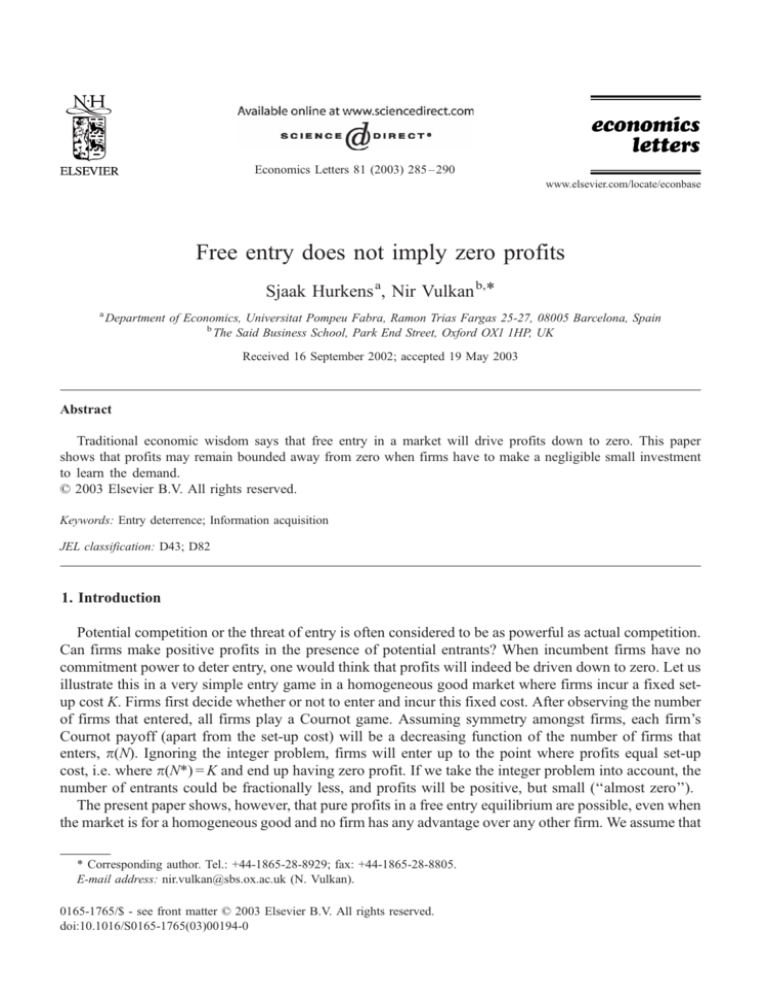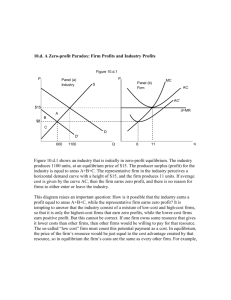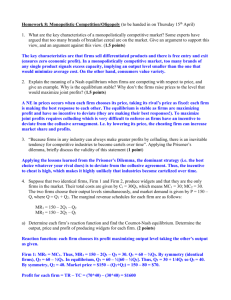
Economics Letters 81 (2003) 285 – 290
www.elsevier.com/locate/econbase
Free entry does not imply zero profits
Sjaak Hurkens a, Nir Vulkan b,*
a
Department of Economics, Universitat Pompeu Fabra, Ramon Trias Fargas 25-27, 08005 Barcelona, Spain
b
The Said Business School, Park End Street, Oxford OX1 1HP, UK
Received 16 September 2002; accepted 19 May 2003
Abstract
Traditional economic wisdom says that free entry in a market will drive profits down to zero. This paper
shows that profits may remain bounded away from zero when firms have to make a negligible small investment
to learn the demand.
D 2003 Elsevier B.V. All rights reserved.
Keywords: Entry deterrence; Information acquisition
JEL classification: D43; D82
1. Introduction
Potential competition or the threat of entry is often considered to be as powerful as actual competition.
Can firms make positive profits in the presence of potential entrants? When incumbent firms have no
commitment power to deter entry, one would think that profits will indeed be driven down to zero. Let us
illustrate this in a very simple entry game in a homogeneous good market where firms incur a fixed setup cost K. Firms first decide whether or not to enter and incur this fixed cost. After observing the number
of firms that entered, all firms play a Cournot game. Assuming symmetry amongst firms, each firm’s
Cournot payoff (apart from the set-up cost) will be a decreasing function of the number of firms that
enters, p(N). Ignoring the integer problem, firms will enter up to the point where profits equal set-up
cost, i.e. where p(N*) = K and end up having zero profit. If we take the integer problem into account, the
number of entrants could be fractionally less, and profits will be positive, but small (‘‘almost zero’’).
The present paper shows, however, that pure profits in a free entry equilibrium are possible, even when
the market is for a homogeneous good and no firm has any advantage over any other firm. We assume that
* Corresponding author. Tel.: +44-1865-28-8929; fax: +44-1865-28-8805.
E-mail address: nir.vulkan@sbs.ox.ac.uk (N. Vulkan).
0165-1765/$ - see front matter D 2003 Elsevier B.V. All rights reserved.
doi:10.1016/S0165-1765(03)00194-0
286
S. Hurkens, N. Vulkan / Economics Letters 81 (2003) 285–290
all firms initially face uncertainty about the demand curve, although they all have the opportunity (before
entry decisions are taken) to resolve their uncertainty at a very small cost. The reader might have expected
that this perturbation of the model would not overturn the zero profit result described in the previous
paragraph as, intuitively, it seems probable that firms will resolve their uncertainty before entry decisions
are taken. However, as will be shown below, the fact that information acquisitions are not observed implies
that an entrant may optimally and rationally decide to stay out, even knowing that the market is large
enough for two competing firms and that only one firm enters. More generally, the number of firms that
enter may be strictly less than the number of firms needed to drive profits down to (almost) zero.
2. Entry with sunk costs and stochastic demand
There are n z 2 firms. They have to decide whether to enter in a new market. Inverse demand in this
market is given by p = x + y q, where q denotes the total production and where both x and y are
stochastic. We assume that the two random variables are independent, and that each can take a high or
low value: x is equal to x H or x L, with probability a and 1 a, respectively. Similarly, y is equal to yH or
y L, with probability b and 1 b, respectively. x H > x L, y H >y L. Firms can become informed about the
realization of (some of) these variables, at a small cost of e>0 per variable. After observing the privately
gathered information, each firm decides whether or not to enter this market, which implies that a cost K
has to be sunk. After observing who entered, the firms that entered compete in the usual Cournot
fashion. We assume that production is at zero cost.
We assume that the variables satisfy the following four assumptions:
(A1)
(A2)
(A3)
(A4)
(xH + yH)2/16 < K;
(xH + yL)2/9>K;
(xL + yH)2/4>K>(xL + yH)2/9;
(xL + yL)2/4 < K.
These assumptions imply that the demand function is such that when x is high, two competing
firms will be able to recover their entry cost. The market is never large enough to support three
competing firms so we may assume without loss of generality that there are only two potential
entrants, A and B1. When x is low and y is high, two competing firms will not be able to recover the
entry cost, but a single firm exercising monopoly power will recover the entry cost. Finally, in the
state where both x and y are low, not even a monopolist would recover its cost.
3. The examples
Example 1. Let a = b = 1/2 and x H = 17, x L = 7, y H = 11, y L = 5, K = 50 (note that (A1)–(A4)
hold).
1
With n z 3 our results are easily extended by having firms 1 and 2 behave as A and B in our examples, and each firm
j > 2 never acquire information and always stay out.
S. Hurkens, N. Vulkan / Economics Letters 81 (2003) 285–290
287
Proposition 1. The information acquisition and entry game given by the parameters in Example 1
exhibits a sequential equilibrium in which only one firm enters in the high–low state. In particular,
the following strategies and beliefs form such a sequential equilibrium 2.
Firm A learns x, and enters only when it is high. If he does not meet a competitor, A believes that
the high–low state occurred and produces the monopoly quantity (x H + y L)/2 = 11. If he does meet a
competitor, A believes that the high–high state prevailed and produces the Cournot quantity
(x H + y H)/3 = 28/3.
Firm B learns y and enters only when it is high. If he does not meet a competitor, B believes that
the low–high state occurred and produces (x L + y H)/2 = 9. If he does meet a competitor, B believes
that the high–high state prevailed and produces (x H + y H)/3 = 28/3.
Proof. Note that all information sets are reached with positive probability. Firms update their beliefs
after observing whether the other firm has entered. If the other firm enters then it must mean that
he has ‘good’ information; if he does not enter, it means that he has ‘bad’ information. Beliefs are,
therefore, consistent. It suffices now to check that the strategies are sequentially rational, given the
beliefs.
It is clear that firms make positive profits whenever they have decided to enter, and that their
production levels maximize their profits given the decision of the other firm. The only deviations
that might be profitable are, (1) for firm A to get complete information and enter additionally in the
case of low x and high y; (2) for firm B to get completely informed and enter additionally in the
case of high x and low y. It is obvious that deviation 1 is not profitable. After observing entry in this
state, firm B will believe that both variables are high and will, therefore, produce (x H + y H)/3 = 28/3.
Firm A’s optimal quantity is, therefore, (x L + y H 28/3)/2 = 13/3 for a profit of approximately 3 18.78,
which is certainly not enough to cover the entry cost of 50.
Deviation 2 is not profitable either. By the same reasoning as before, entry by firm B will imply
that firm A believes demand is very high and produces (xH + yH)/3 = 28/3. The optimal production
level for firm B is, therefore, (xH + yL 28/3)/2 = 19/3, yielding a profit of 40.11, which is again not
enough to cover the entry cost. 5
This example thus shows that there exists a sequential equilibrium of the information acquisition
and entry game in which in the high–low state only one firm will enter, when in fact two firms
competing à la Cournot would make profits. Even zero information cost does not destroy this
equilibrium. The result is driven by the fact that when firm B deviates and enters in the high–low
state, firm A is deceived and overestimates demand, which in turn leads to overproduction (relative
to the Cournot equilibrium) which makes entry not profitable for the deviating firm, at least for
some range of the parameters.
Notice that in the equilibrium described in Proposition 1, all information sets are reached with positive
probability. Beliefs are determined by Bayes’ rule and are not exogenously and carefully designed to
support the equilibrium strategies. Hence, this equilibrium will satisfy any refinements of sequential
equilibrium based on restrictions on out-of-equilibrium beliefs (such as the Intuitive Criterion of Cho
and Kreps, 1987).
2
3
See Kreps and Wilson (1982) for a formal definition.
We will round off all payoffs to two decimals.
288
S. Hurkens, N. Vulkan / Economics Letters 81 (2003) 285–290
Consider a small variation of our model of information acquisition. Suppose that firms can also gather
information after entry has taken place but before production is determined. This variation does not
destroy the validity of Proposition 1. Namely, firms will not find it optimal to spend money to do late
research, since Bayesian updating along the equilibrium path already yields full information.
One might believe that the fact that firms become (at first) only partially informed is crucial. The next
example shows that this is not true.
Example 2. Let a = 1/10, b = 1/2, and x H = 19, x L = 7, y H = 13, y L = 7, K = 70 (note that assumptions
(A1)–(A4) are satisfied).
Proposition 2. In the information acquisition and entry game given by the parameters in Example 2,
the following strategies and beliefs form a sequential equilibrium in which only one firm enters in the
high–low state:
s A: Firm A learns x and y and enters, except in the low – low state of demand. If he does not meet a
competitor, he produces the corresponding monopoly quantity (16, 13 or 10). If he does meet a competitor in
the high – high state of demand, he produces (x H + y H)/3 = 32/3. If he meets a competitor in the high – low state
of demand, A believes that the competitor entered without having gathered any information, and he produces
qAhl = 953/102. If he meets a competitor in the low –high state of demand, A believes that the competitor
lh
entered without having gathered any information, and he produces qA
= 647/102.
B
s : Firm B learns x and y, and enters only when both are high. If he does not meet a competitor, he
produces the monopoly quantity (x H + y H)/2 = 16. If he does meet a competitor he produces the Cournot
output (x H + y H)/3 = 32/3.
Proof. Let us check that the beliefs are consistent. Consider the possibility that firm B trembles with
small probability d, in which case he does not gather information and decides to enter. When he does not
meet a competitor he produces (x L + y L)/2 = 7, when he does meet a competitor he produces 373/51. Let
all other pure information acquisition and entry decisions occur with probability of order d2. When firm
A meets a competitor when demand is high–high, he will assign probability of almost 1 to the event that
firm B did not tremble. When firm A meets a competitor when demand is high–low or low–high, belief
revision will imply that firm A believes with probability of almost 1 that firm B trembled and entered
without having gathered information. As d ! 0 the fully mixed strategy pair converges to (s A, s B), while
the beliefs generated by the fully mixed strategy pair converge to the beliefs described above.
Now we have to check that the strategies s A, s B are sequentially rational, given the beliefs. It is clear
that firm A’s strategy is optimal along the equilibrium path. How much should firm A produce in case he
meets a competitor when demand is high–low or low–high? When firm B has trembled and finds
himself in the situation where he entered without having gathered information and meeting a competitor,
he will discard the possibility of a low–low demand state. He will update his beliefs using Bayes’ rule:
lhh ¼
ab
1
¼
1 ð1 aÞð1 bÞ 11
lhl ¼
að1 bÞ
1
¼
1 ð1 aÞð1 bÞ 11
S. Hurkens, N. Vulkan / Economics Letters 81 (2003) 285–290
llh ¼
289
ð1 aÞb
9
¼
1 ð1 aÞð1 bÞ 11
Now it can be verified that qB = 373/51 maximizes qB(lhh(x H + y H (x H + y H)/3 qB) + lhl(x H + y L qAhl qB) + llh (x L + y H qAlh qB)), while qAhl = 953/102 maximizes qAhl (xH + yL qB qAhl), and qAlh =
647/102 maximizes qAlh(x L + y H qB qAlh ). The strategy of firm A is indeed optimal, given the beliefs.
Firm B’s strategy is also optimal along the equilibrium path. However, we have to consider whether
a deviation by entering in the high–low or low–high state of demand is profitable. The best production
level for firm B after entering in the high–low demand state is q=(x H + y L qAhl )/2 = 1699/204, which
yields benefits of q2 K c 0.64 < 0. It is, therefore, not profitable to deviate and to enter in the case
of high–low demand, given the expectations of firm A. Similarly, entering in the low–high state is not
profitable since the optimal production level would be equal to (x L + y H qAlh )/2 = 1393/204, and the
loss (c 23.37) would be even greater.
In this example firms learn demand perfectly in equilibrium. However, in the high–low state of
demand only firm A enters. Were firm B to deviate and enter in this state, then firm A would be faced
with an unexpected event and might believe that firm B made a mistake and entered without having
gathered information. The uninformed firm B would then assign relatively high probability to the low–
high state, and produce only 373/51 c 7.31, which is less than the production level of a Cournot
duopolist in the high–low state (26/3 c 8.67). This implies then that firm A would produce more than
that level (953/102 c 9.34) which then makes the deviation by B unprofitable.
4. Conclusion
Our examples show that when potential entrants need to acquire information about the profitability of
the market, the number of firms that in fact enter is not necessarily determined by the (almost) zero profit
condition, even when information acquisition is almost free and firms do in fact acquire the information
in equilibrium. This casts some doubt on the literature that uses the zero profit condition to derive certain
results. For example, Dixit and Stiglitz (1977) use the zero profit condition to derive the degree of
product diversity. Empirical papers as Bresnahan and Reiss (1988, 1990, 1991) estimate market size
based on the entry decision of firms. As our examples show, however, the fact that only one firm enters
does not necessarily mean that the market is too small for two firms.
We have assumed Cournot competition in the production stage, but our claim that beliefs may bar
entry also holds for other oligopolistic competition forms like price competition with differentiated
products or rent seeking contests.
Acknowledgements
Hurkens gratefully acknowledges financial support from CIRIT, Genaralitat de Catalunya, grant
1997SGR 00138 and DGES grant PB96-0302. Vulkan gratefully acknowledges financial support from
the EPSRC, grant no. M07052 and from the ESRC grant no. R000222642.
290
S. Hurkens, N. Vulkan / Economics Letters 81 (2003) 285–290
References
Bresnahan, T., Reiss, P., 1988. Do entry conditions vary across markets. Brookings Papers on Economic Activity 3,
833 – 881.
Bresnahan, T., Reiss, P., 1990. Entry in monopoly markets. Review of Economic Studies 57, 531 – 553.
Bresnahan, T., Reiss, P., 1991. Entry and competition in concentrated markets. Journal of Political Economy 99, 977 – 1009.
Cho, I.K., Kreps, D.M., 1987. Signalling games and stable equilibria. Quarterly Journal of Economics 102, 179 – 221.
Dixit, A., Stiglitz, J., 1977. Monopolistic competition and optimum product diversity. American Economic Review 76,
297 – 308.
Kreps, D., Wilson, R., 1982. Sequential equilibrium. Econometrica 50, 863 – 894.








